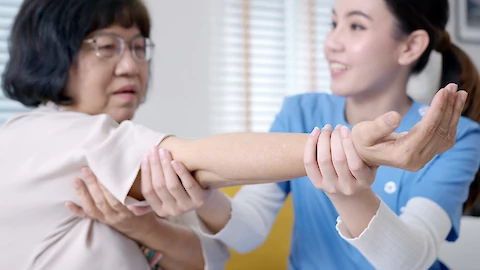
Bones weaken after age 50. Without preventive treatment, the resulting bone loss can lead to weakened bones that can result in fractures. Much of the damage caused by osteoporosis can be reduced with lifestyle changes and medical interventions. Women are especially at risk post-menopause because of the loss of estrogen that helps build bone mass.
Lifestyle Changes to Manage Osteoporosis
Changes in how people over the age of 50 live can reduce bone loss. With proper diet and exercise, seniors can maintain a stronger bone structure. In many situations, seniors may require medical intervention such as pills, intravenous medication, or injections. Medical treatments combined with lifestyle changes can reduce bone loss.
Diet
Seniors at risk for osteoporosis should ensure they have enough calcium and Vitamin D in their diet. Dairy products and green vegetables such as broccoli and kale are primary sources of dietary calcium. The National Institute of Health (NIH) recommends 1200 mg for women over the age of 50 and 1000 mg for men. Men over the age of 70 should increase their calcium intake to 1200 mg per day.
An easy way to estimate the amount of calcium in dairy servings is to multiply the number of servings by 300 mg. For example, a senior would need to consume 8 ounces of milk, a cup of yogurt, and 2 ounces of hard cheese to consume roughly 1200 mg of calcium per day. For many people, a daily supplement is required to ensure that the requirement is met.
Vitamin D is equally important to bone health. Low levels of Vitamin D can impede the body's ability to absorb calcium. No recommended levels have been set for Vitamin D. Seniors should speak with a healthcare provider to determine their daily dose. Most people require a supplement to maintain adequate levels of Vitamin D.
Recent studies found that consuming more than two alcoholic beverages per day increases the risk of fractures. Alcohol impedes the body's ability to absorb nutrients such as calcium and Vitamin D. It may also interfere with the body's production of osteoblast, which affects osteoporosis.
Exercise
Exercise helps improve bone mass and bone density in pre- and post-menopausal women. Also, exercise helps strengthen muscles and improve balance to reduce the chance of a fall. At a minimum, seniors should exercise at least 30 minutes three times a week. However, everyone should consult a physician before starting an exercise program.
If consistent exercise stops, so does its contribution to bone health. Seniors should develop a routine that ensures a minimum of exercise each week. Seniors living in the Asheville area of North Carolina have several walking trails that can add variety to weekly exercising. Try the Botanical Gardens at the University of North Carolina or the Beaver Lake Bird Sanctuary, with its convenient benches and overlooks.
Stop Smoking to Manage Osteoporosis
Smoking increases the speed at which bone loss occurs. For pre-menopausal women who smoke, bone density can reduce by 5% to 10% when entering menopause. Added loss during and after menopause raises the risk of fracture.
Bone density loss is only one of many adverse health outcomes of smoking. Seniors should be encouraged to stop or reduce their smoking for maximum health.
Senior Helpers of Asheville
Lifestyle changes can go a long way to improving osteoporosis. However, those changes may be difficult to achieve alone. Senior Helpers provides in-home care to the communities of Asheville, Hendersonville, Arden, and Fletcher. Contact us to learn more.